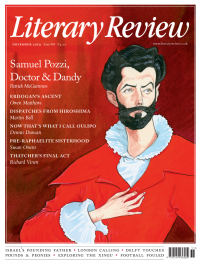Elain Harwood
Ring Road Nation
Boom Cities: Architect-Planners and the Politics of Radical Urban Renewal in 1960s Britain
By Otto Saumarez Smith
Oxford University Press 198pp £65
The only thing wrong with Otto Saumarez Smith’s book is its title. Far from booming, at the start of the 1960s the towns and cities of the Midlands and the north of England, and their Welsh, Scottish and Irish counterparts, were dirty, despoiled monuments to a bygone age, from which the young and talented fled south. After more than a century of being out of step, London was reasserting its traditional dominance and defying all attempts to restrict its growth. Leicester, for instance, relatively prosperous among Midlands cities, saw the steady decline of its traditional hosiery and shoe industries from the 1950s onwards. In such towns, industry and retail became concentrated in the hands of a few large-scale businesses.
One solution to these problems lay in the local authorities’ own hands. Their income from industrial rates was limited by government controls, while the population exodus from city centres reduced the number of residents paying domestic rates. But most authorities had large central landholdings, perhaps a wholesale or retail market (or both), an abattoir, a tram shed or a council depot ripe for redevelopment for commercial purposes. Furthermore, the land acquired for inner ring roads made more sites available for shops and showrooms. A town could reinvent itself by attracting fashionable chain stores and supermarkets, reached by broad new roads, with car parking close at hand.
Commercial developers quickly saw the opportunities available to them in helping local authorities realise their dreams. They could build on a larger scale than individual shopkeepers and even fund the construction of hotels – the ultimate prize for any local authority seeking to bring trade and cachet to

Sign Up to our newsletter
Receive free articles, highlights from the archive, news, details of prizes, and much more.@Lit_Review
Follow Literary Review on Twitter
Twitter Feed
The son of a notorious con man, John le Carré turned deception into an art form. Does his archive unmask the author or merely prove how well he learned to disappear?
John Phipps explores.
John Phipps - Approach & Seduction
John Phipps: Approach & Seduction - John le Carré: Tradecraft; Tradecraft: Writers on John le Carré by Federico Varese (ed)
literaryreview.co.uk
Few writers have been so eagerly mythologised as Katherine Mansfield. The short, brilliant life, the doomed love affairs, the sickly genius have together blurred the woman behind the work.
Sophie Oliver looks to Mansfield's stories for answers.
Sophie Oliver - Restless Soul
Sophie Oliver: Restless Soul - Katherine Mansfield: A Hidden Life by Gerri Kimber
literaryreview.co.uk
Literary Review is seeking an editorial intern.